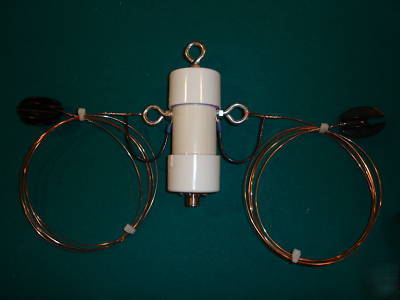Kenosha Reuse Discussion Board > GURNEE, IL
> Commercial
> Automative
> Used
> 15 meter dipole antenna, inverted v, for ham, amateur
15 meter dipole antenna, inverted v, for ham, amateur
15 Meter Dipole Antenna, Inverted V
This is a 15 meter, conventional, center-fed, half-wave dipole antenna. Unlike other antennas, this one has direct connections to the antenna wire to avoid "scratchiness" in the receiver from antenna movement in the wind. The antenna is smooth with no sharp edges that radiate harmonics. The RF connector is the standard SO-239 for use with standard 52-75 ohm coaxial feedlines. Included are two end insulators for quick installation. The dipole antenna does not need a center support. However, a top eye bolt is included for center mounting in an inverted V configuration. The side eye bolts allow for a variety of antenna mounting angles without wire pinching. The side eye bolts also allow for the connection of additional wire legs to support multband antenna designs. The center section is sealed and weather-proof. All joints are soldered.
The default length of the antenna is 22' 4" for the CW portion of the band (21.0 mhz.). It can then be shortened in the field to move up the band. If you would like a specific resonant frequency I can do that for no extra charge.
Bare copper wire has been the first choice for wire antennas for years. Copper wire will not rust like steel antennas and has extremely high conductivity resulting in a lower signal losses. Also, bare copper wire has no dielectric insulation which greatly reduces capactance compared to insulated wire resulting in more sensitive antenna. The wire used in this antenna is 18 gauge Copperweld wire. It is 40% copper coated solid steel wire that is stronger than the same gauge solid or stranded copper wire (240 lbs tensile strength). This wire is designed for antenna construction. It will not stretch like building center copper wire so the antenna will stay tuned. Other antenna manufacturers use less expensive Copperweld wire that only contains <30% copper. Its important to have a thick layer of copper not only for good conductivity but for flexibility and durability.

